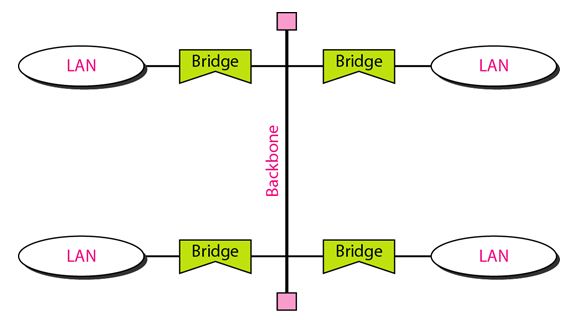Backbone Networks
A backbone network allows several LANs to be connected. In a backbone network, no station is directly connected to the backbone; the stations are part of a LAN, and the backbone connects the LANs. The backbone is itself a LAN that uses a LAN protocol such as Ethernet; each connection to the backbone is itself another LAN. The most widely used backbone networks are as follows: the bus and the star.
Bus Backbone:
In a bus backbone, the topology of the backbone is a bus. The backbone itself can use one of the protocols that support a bus topology such as 10Base5 or 10Base2.
Bus backbones are normally used as a distribution backbone to connect different buildings in an organization. Each building can comprise either a single LAN or another backbone (normally a star backbone).
A good example of a bus backbone is one that connects single- or multiple-floor buildings on a campus. Each single-floor building usually has a single LAN. Each multiple-floor building has a backbone (usually a star) that connects each LAN on a floor. A bus backbone can interconnect these LANs and backbones. The following figure shows an example of a bridge-based backbone with four LANs.
In the above figure, if a station in a LAN needs to send a frame to another station in the same LAN, the corresponding bridge blocks the frame; the frame never reaches the backbone. However, if a station needs to send a frame to a station in another LAN, the bridge passes the frame to the backbone, which is received by the appropriate bridge and is delivered to the destination LAN. Each bridge connected to the backbone has a table that shows the stations on the LAN side of the bridge. The blocking or delivery of a frame is based on the contents of this table.
For Further Reading:
Different Connecting Devices
Loop problem in Transparent Bridges
Star Backbone Networks
Connecting Remote Lans
Back to DCN Questions and Answers


